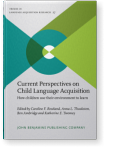Language disorders and autism
Implications for usage-based theories of language development
Usage-based theories explain language development in terms of the specific characteristics of language input in combination with a child’s own inherent ability to engage in shared intentionality and statistical learning. In this chapter, I discuss these mechanisms in relation to evidence from Developmental Language Disorders (DLD) and Autism. First, there is evidence for the role of language input in both conditions. The specific patterns of morpho-syntax impairments in DLD are clearly affected by the relative perceptual salience, frequency and complexity of morpho-syntax in the specific language a child is acquiring. Regarding autism, the grammatical complexity of parental child-directed utterances predicts child vocabulary and morpho-syntactic skills at later time-points. Nonetheless, both conditions are highly heritable, raising questions about the child-internal mechanisms leading to language learning difficulties. Impairments in statistical learning could potentially account for morpho-syntactic difficulties in DLD. However, any firm conclusions await assessments of statistical learning which have good test – retest reliability. Autistic children might plausibly tend to have difficulties with – or lack motivation for – engaging in shared intentionality. If verified, this could account for patterns of relatively spared nuts-and-bolts (structural, core) language in the face of pragmatic language difficulties. However, to date studies of autistic difficulties with shared intentionality have not stringently ruled out alternative explanations. Both DLD and autism are likely to exist on a continuum with the neuro-typical population. Future research needs to move towards designs which can more fully accommodate the vast heterogeneity that exists within both DLD and autism.
Article outline
- Preface
- Introduction
- Theories of language development
- Usage-based theory
- Shared intentionality
- Statistical learning / distributional analysis
- From exemplar-learning to the learning of syntactic constructions
- Properties of the language input
- Usage-based predictions for language development
- Developmental Language Disorder (DLD)
- Autism
- Statistical learning in autism
- The role of language input for language development in Autism Spectrum Conditions
- Shared intentionality
- Is shared intentionality atypical in autism?
- Joint Attention:
- Collaboration:
- Would difficulties in shared intentionality lead to impairments in nuts-and-bolts language?
- Would difficulties in shared intentionality lead to impairments in pragmatics?
- General conclusions
- Summary
- Future directions
-
Note
-
References
